A sample text widget
Etiam pulvinar consectetur dolor sed malesuada. Ut convallis
euismod dolor nec pretium. Nunc ut tristique massa.
Nam sodales mi vitae dolor ullamcorper et vulputate enim accumsan.
Morbi orci magna, tincidunt vitae molestie nec, molestie at mi. Nulla nulla lorem,
suscipit in posuere in, interdum non magna.
|
Just a quick post to let the Atlanta-area readers of this blog (both of you) know that I’ll have a table at Riverfest on Saturday, May 8 2010. There’s an admission fee, but that fee includes bands, barbeque and beer and the proceeds go to neighborhood groups and charities. If you make it, do stop by and say hello!
Writing in tiny wee writing is particularly well suited for framing in tiny wee frames. One of my thrift shop runs provided me with a rather elaborate frame with a two-inch-by-three-inch window. I decided, as an experiment, to see if I could fit a poem in it. Since the poem itself wasn’t that long, I added some white space in the shape of a flame with the help of the French curves provided by my father.
The only word I had to omit from the original poem for it to fit the boundaries I’d set was the word “perfect.”
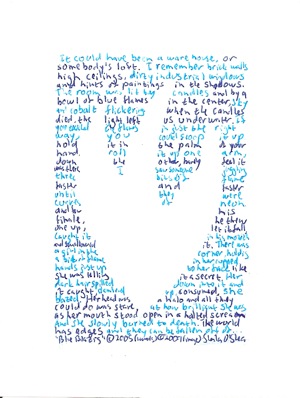 Blue Blazing It could have been a warehouse,
or somebody’s loft.
I remember brick walls
high ceilings,
dirty industrial windows
and hints of paintings in the shadows.
The room was lit by candles
and by a bowl of blue flames in the center,
sky and cobalt flickering.
When the candles died, the light left us underwater.
If you touched the flames in just the right way, you could scoop some up
hold it in the palm of your hand,
roll it up one arm,
down the other, barely feel it was there.
I saw someone juggling three bits of flame
faster and faster
until they were [perfect] curves of neon,
and for his finale, he threw one up, let it fall
caught it in his mouth
and swallowed it.
There was a girl in the corner,
holding a bit of flame in her cupped hands just up to her face
like she was telling it a secret.
Her dark hair spilled down into and
it caught
clambered up,
consumed.
She blazed.
Her head was a halo and all they could do was stare
at how brilliant she was
as her mouth stood open in a halted scream
and she slowly burned to death.
The world has edges
and they can be fallen off of . . .
The poem had been previously published (albeit with a line missing) in the Java Monkey Speaks Volume One, which was an anthology of poets who had featured at the first two years of the Java Monkey Speaks reading. My life as a poet has been a scattershot one, but I mark that as an achievement worth noting, up there with being published in another poetry anthology a few pages away from Neil Gaiman and having the opportunity to recite my work in front of a Basquiat painting at the High Museum of Art.
It’s one of the only free verse poems of mine I have memorized, so when I mention I did poetry at one time and people ask “So, what kind of poetry?” I’ve been known to recite that one and then say “stuff like that.”
Prints of this work are available here.
The original is not for sale.
I’d bought a handful of small frames from a thrift superstore that opened recently near where I live. This was made on a small piece of paper cut to fit that frame. I started with two pens and the general idea to alternate colors with more lines per color as I progressed. I pretty much did the whole thing in one sitting while listening to jazz at The Glenwood one fine Wednesday night.
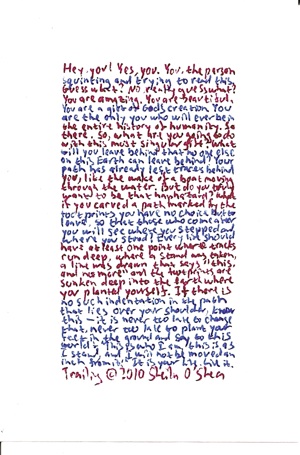 Trailing Hey, you!
Yes, you.
You, the person squinting and trying to read this.
Guess what?
No, really, guess what?
You are amazing.
You are beautiful.
You are a gift of God’s creation.
You are the only you who will ever be in the entire history of humanity.
So there.
So, what are you going to do with this singular gift?
What will you leave behind that no one else on this Earth can leave behind?
Your path has already left traces behind you, like the wake of a boat moving through the water.
But do you truly want to be that haphazard?
What if you carved a path marked by the footprints you have no choice but to leave, so that those who come after you will see where you stepped and where you stood?
Every life should have at least one point where tracks run deep, where a stand was taken, a line was drawn that says “this, and no more” and the footprints are sunken deep into the earth where you planted yourself.
If there is no such indentation in the path that lies over your shoulder, know this–it is never too late to plant your feet in the ground and say to this world: “This is who I am, this is as I stand, and I will not be moved an inch from it.”
It is your life. Live it.
It was the first piece I ever sold. At the opening of the Upper West Side Folk Art Market, even as the snow was coming down as thick and fast as I’ve ever seen it come in Atlanta, a few brave souls came out and one of those brave souls was a man named Ernest, who loved my work from the beginning and decided to buy a piece as a Valentine’s Day gift for his wife. I read the words to him and the deal was sealed. All seventeen dollars of it.
I promptly spent the money that very evening on a small bowl of Pho Tai at So-Ba and a cover charge to see two loud rock bands at 529. (The Forty-Fives and The Howlies. I highly recommend both of them.) It was that kind of a night.
Prints of this work are available here.
The original has been sold.
By the time I’d gotten to Neptune, it was the fourth of the planetary Word Art pieces I had done on that particular Thursday and I was enormously relieved that Pluto was no longer on the list. I was worried I wouldn’t find much to write about since its far distance meant that, like Uranus, there were no ancient myths surrounding it and not much in the way of exploration, either. Fortunately, there was one thing that fascinated me–the astronomical race to be the first to officially discover the planet once the possibility of its existence came to light.
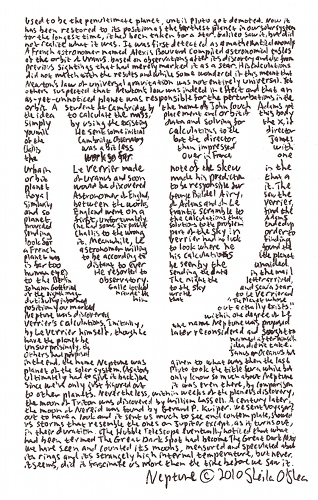 Neptune Used to be the penultimate planet, until Pluto got demoted.
Now it has been restored to its position as the farthest planet in our solar system.
For the longest time, it had been taken as a star.
Galileo saw it, but did not realize what it was.
It was first detected as a mathematical anomaly.
A French astronomer named Alexis Bouvard compiled astronomical tables of the orbit of Uranus, based on observations after its discovery and also from previous sightings that had merely marked it as a star.
His calculations did not match with the results and while some wondered if this meant that Newton’s law of universal gravitation was not entirely universal.
Yet others suspected that Newton’s law was indeed still in effect and that an as-yet-unnoticed planet was responsible for the perturbations in the orbit.
A student at Cambridge by the name of John Couch Adams got the idea to calculate the mass, placement and orbit of this body simply by using the existing data and solving for the x, if you will.
He sent some initial calculations to the director of the Cambridge Observatory but the director, James Challis, was a bit less than impressed with the work so far.
Over in France, one Urbain Le Verrier made note of the skew in the orbit of Uranus and soon made his prediction that a planet would be discovered to be responsible for it.
The Royal Astronomer of England, George Biddel Airy, saw the similarity between the works of Adams and of Le Verrier, and so England went on a frantic scramble to find the planet first.
Unfortunately, the calculations that Adams provided (he had some six possible solutions to the problem) ended up sending Challis to the wrong part of the sky in order to look for it.
Meanwhile, Le Verrier had no luck finding a French astronomer willing to look where he found the planet was to be according to his calculations (the planet is far too distant to ever be seen by the unaided human eye.)
He resorted to sending the data in the mail to the Berlin Observatory.
The night the letter arrived, Johann Gottfried Galle looked to the sky and saw a star of the eighth magnitude.
He wrote to Le Verrier and dutifully informed him that “The planet whose position you marked out actually exists.”
Neptune was discovered within one degree of Le Verrier’s calculations.
Initially, the name Neptune was proposed by Le Verrier himself, though he later reconsidered and sought to have the planet be named after himself.
Unsurprisingly, the idea didn’t take.
Others had proposed Janus or Oceanus, but in the end, the name Neptune was given to what was then the last planet of the solar system.
(As above, Pluto took the title for a while but ultimately had to give it back.)
We only know so much about Neptune since we’ve only just figured out it was even there, by comparison to other planets.
Nevertheless, within weeks of the planet’s discovery, the moon of Triton was discovered by William Lassell.
A century later, the moon of Nereid was found by Gerard P. Kuiper.
We sent Voyager 2 out to have a look and it sent us much to see and contemplate, showed us storms that resemble the ones on Jupiter except, as it turns out, in their duration.
(The Hubble Telescope eventually noticed that what had been termed The Great Dark Spot eventually had become the Great Dark Not.)
We have seen and counted its moons, measured and speculated about its rings and its strangely high internal temperature, but never, it seems, did it fascinate us more than the time before we saw it.
I finished a little before ten o’clock that night and was left both restless and exhausted. Friday morning was spent doing last minute scanning and framing and packing all the planets up to take to Chattanooga with me. None of them sold at the time, but I received many compliments on my work and it gave me some glimmer of hope that this crazy scribbly thing I do may will be of interest to others.
Prints of this work are available here.
The original is not for sale.
At this point, I don’t have my artwork framed professionally but make use of standard photo frames from thrift shops and dollar stores. Not only am I too broke to afford much more, I prefer to be able to remove the art easily in order to scan it or make minor corrections.
I picked up a frame on one of my thrift shop runs that resembled a television screen and made an earlier attempt to fill it with words that would look like static but I got bored with what I was doing about a third of the way through it and abandoned it. I started again, this time coming up with an eye design in GIMP and tracing the printout. I got about halfway through it and set it aside before finally finishing it up over a glass of bourbon at a brewpub within walking distance of my home.
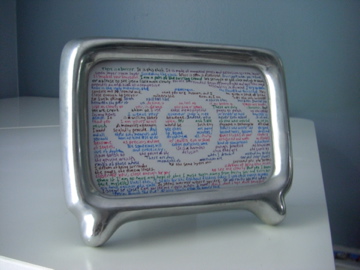 Peering Through the Eye There is a barrier.
It is this thick.
It is made of magazine pages and television screens, layer upon layer upon layer.
Something like glass.
What is seen is distorted.
You ripple when you move.
It makes you beautiful.
I am a part of the swirling crowd.
We struggle to get close enough to touch, or at least to see just a little more clearly.
You are surrounded from so many angles and each flat image provides an addition to a composite assembling in my mind.
I try to even take in the ugly moments, the pettiness, the flaws and fumblings.
They console me so, remind me that you are human, and I am given a sense of being close enough to see you vulnerable, even as I am not the only witness to such things.
It can still feel like a secret that has been shared just between the pair of us.
At times it can feel as if my broken up places are known just as clearly to you, in the ways you sing or speak.
These are only illusions.
And yet we crave them so.
I use the newspapered pages to patch up the cracks in my heart.
I weave your glamour into a net in order to hold myself in place.
It is a willing sort of bondage.
Indeed, you never even asked it of me.
And yet I am yours to call upon.
You ask so little of one who would give so much.
A moment’s attention would be such tiny payment in exchange for all that I would so gladly provide.
And yet there are many others who would do the same and all those tiny moments add up, become minutes, become hours, become days and you would have no time left to do anything at all.
And so those flickers of your regard become as precious and rare as jewels, cut to shine, treasured and worn as symbols of status.
We sometimes carve ourselves some kind of semiprecious substitute out of daydream and creativity.
(It is a harmless enough practice as long as one is not foolish to the point of delusion that they are the same as the genuine article.)
There are days when I dream of ascending to the ranks of those whose moments of attention are carved into jewels.
I dream of being surrounded by the same layers that surround you, the screens, the pages, the camera lenses.
I dream of being that much closer to you, close enough for you to see me clearly.
(And yet I know that if I am to have any hope of that I must turn away from facing you and turn to face myself.)
Until then, I settle for the fishbowl flickers when I get close enough to press my hand against the glass.
It seems warmer where you are.
Do you really see me when I stand so close?
Can you see me ripple when I move?
Am I, dare I hope, made beautiful?
The first seven lines had been composed in my head as the start of a poem and stayed in limbo for many years. Writing them down as the start of this piece forced the issue. I did a bit of notebook drafting for this one but, as always, the words tended to shift a bit between initial composition and execution.
Is it about anyone in particular? It is, in a sense, about a lot of people, about the nature of celebrity obsession as I have experienced it and witnessed it. I can’t imagine a better frame for it, really.
Prints of this work are available here.
The original is not for sale.
Sometimes people still ask me if Twitter is useful for anything. I have to say it’s managed to keep me informed of many things, whether it’s finding out about a Henry Rollins gig at the last minute or pointing me to blog entries and news items that I would have otherwise known nothing about.
One day, @neilhimself retweeted an announcement by @neverwear for a contest requesting artistic depictions of Cabal the Dog.
“Hey,” I thought, “I happen to have an artistic depiction of Cabal the Dog handy. I think I’ll send it in!”
And so I did and thought absolutely nothing of it beyond that. And another fine day came along when Mr. Gaiman retweeted the announcement of the winners.
“Hm,” I thought, “I wonder who won that? Surely it wasn’t me.” So I tapped the link and read on my little iPhone screen and nearly dropped my phone in shock to see my scribbly little depiction was among the eight winners to be printed in a limited edition postcard set. Then I read further and found out that I was also the winner of a print signed by Neil Gaiman.
Once I’d gotten to a proper computer, I posted a hello and expressed my amazement. Then I had to figure out how to get a 300 dpi file out of the hasty snapshots of the work I’d taken before framing it and giving it away. (Thankfully, I have a dad who knows his way around PhotoShop, and he was able to clean it up for me and make it presentable.)
The print arrived in my mailbox not long after and I knew if I waited until I had enough money to get it properly framed the thing would be sitting for months in a mailing tube, so I went and got it improperly framed instead.
The print itself measured 18″ by 12″ which, I quickly discovered, is not exactly a standard frame size. I paced up and down the aisles of my local craft store and finally settled on a simple 14″ by 18″ frame. All the way home, I pondered strategies for filling in the two inch gap, mentally going through my inventory of hoarded art supplies from my previous life as a picture framer and wondering what I’d still managed to hold onto over the past several moves. I go through cycles of packrattery and purgation that are probably not helped by the fact that every once in a while something I still have stowed somewhere manages to come in handy.
Like, for example, a length of cash register tape that I’d scribbled the hell out of over the course of I’m not even sure how many days. I’d found it recently while sorting through some boxes and I’d planned to photograph it and post it on this blog as a fascinating example of proto-word-art. Instead I folded it to fit inside the frame and fill in the gap just under the signature.
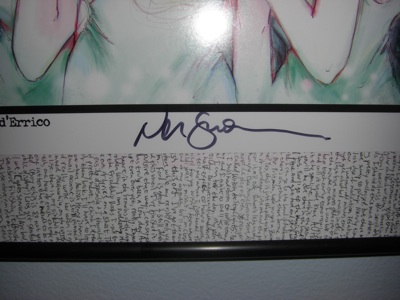 Actually Scribbled On By Neil Gaiman Himself What do my words say? I’m not entirely sure. They weren’t intended as artwork, just a scrap paper head dump in lieu of a catbook. But they filled the space nicely and they’ll work for now until I have enough money to pay a professional framer.
 How to Talk to Girls at Parties I’ll be sure to let people know as soon as the postcard set is available. Or, at the very least, I’ll retweet about it.
This planet is, of course, the one that makes schoolboys snicker upon the mere mention of the name. The symbol only makes it worse, I fear–all you’d need to do is add a pair of hands and you’d practically have a pictogram for goatse.
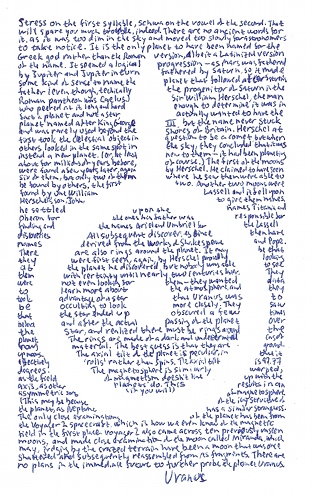 Uranus Stress on the first syllable, schwa on the vowel of the second. That will spare you much trouble, indeed.
There are no ancient words for it, as it was too dim in the sky and moved too slowly for astronomers to take notice.
It is the only planet to have been named for the Greek god rather than the Roman version, albeit a Latinized version of the name.
It seemed a logical progression–as Mars was fathered by Jupiter and Jupiter in turn fathered by Saturn, so it made some kind of sense to name the planet that followed after Saturn’s father (even though, technically the progenitor of Saturn in the Roman pantheon was Caelus.)
Sir William Herschel, the man who peered at it long and hard enough to determine it was in fact a planet and not a star, actually wanted to have the planet named after King George III, but the name never stuck and was rarely used beyond the shores of Britain.
Herschel at first took the celestial object in question to be a comet, but when others looked in the same spot in the sky, they concluded that it was instead a new planet.
(Or, at least, new to them–it had been planeting about for millions of years before, of course.)
The first of the moons were found a few years later, again by Herschel.
He claimed to have seen six of them, but only two of them where he saw them were able to be found by others, the first two.
Another two moons were found by one William Lassell and it fell upon Herschel’s son, John, to give them names.
He settled upon the names Titania and Oberon for the ones his father was responsible for finding and the names Ariel and Umbriel for the Lassell discoveries.
All subsequent discoveries since then have names derived from the works of Shakespeare and Pope.
There are also rings around the planet.
It may be that they were first seen, again, by Herschel proudly looking at the planet he discovered, but nobody was able to see them with certainty until nearly two centuries later.
They were not even looking for them–they wanted data to learn more about the atmosphere and they took advantage of a star that Uranus was to be occulting to look more closely.
They saw that the star ended up obscured a few times before and after the actual passing of the planet over the star, and realized that there must be rings around the planet.
The rings are made of a dark and undetermined (as of now) material.
The best guess is that they are ground up moons.
The axial tilt of the planet is peculiar, in that it effectively ‘rolls’ rather than spins.
The axial tilt is 97.77 degrees. The magnetosphere is similarly warped, as the field of magnetism doesn’t line up with the axis, as other planets do.
This results in an asymmetric sort (if you will) of magnetosphere.
(This may be because of the icy structure of the planet, as Neptune has a similar strangeness.)
The only close examinations of the planet has [sic] been from the Voyager 2 spacecraft, which is how we even know of the magnetic field in the first place.
Voyager 2 also came across ten previously unseen moons, and made close examination of the moon called Miranda, which may, judging by the crazed terrain have been a moon that was once shattered and subsequently reassembled from its fragments.
There are no plans in the immediate future to further probe the planet Uranus.
Yes, you’re absolutely right, I didn’t have to go there, but understand that this was after I’d just finished Jupiter and Saturn in a mad dash to finish the planets by the end of Thursday and I was eager to finish it so I could move on to Neptune and be done with it. So I went for the dumb joke. Sorry about that.
Prints of this work are available here.
The original is not for sale.
Last night I met someone–the new friend of an old friend–who had a symbol for Saturn worked into a tattoo on his arm. It was, to my momentary bafflement, entirely unlike the symbol for Saturn that I’d traced and rendered into Word Art. The symbol he’d chosen was one that dated back to Medieval times whereas the one I’d used had been swiped from the NASA website. It struck me as an interesting object lesson in the mutability of symbols over time.
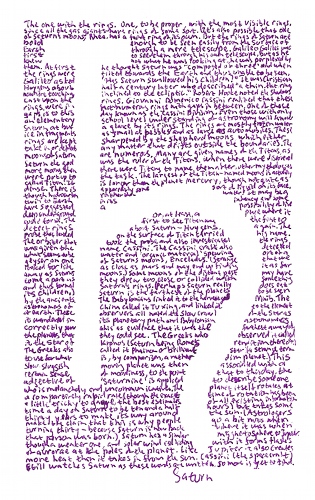 Saturn The one with the rings.
One, to be proper, with the most visible rings, since all the gas giants have rings of some sort.
(It’s also possible that one of Saturn’s moons, Rhea, has a faint ring of its own.)
But the rings of Saturn are bold enough to be seen easily from the surface of Earth through a mere telescope.
Galileo Galilei was first to see them through his own telescope, but as he knew now what he was looking at, he was perplexed by them.
At first he thought Saturn was “composed of three” and when the rings were tilted towards the Earth and thus unable to be seen, Galileo asked “Has Saturn swallowed his children?”
It was Christian Huygens, about half a century later who described “a thin, flat ring, nowhere touching, inclined to the ecliptic.”
Robert Hooke noted the shadows cast upon the rings.
Giovanni Domenico Cassini realized that these rings were in fact numerous rings with gaps in between.
One of these gaps is to this day known as the Cassini Division.
Even those with only an elementary school level understanding of astronomy will know Saturn at but a glance by its rings.
The rings are mostly frozen water ice in fragments as small as pebbles and as large as automobiles.
These rings are kept sharpened by the shepherd moons, which either take in or deflect any matter that drifts outside the boundaries.
The moons of Saturn are numerous. Many are given names of the Titans as Saturn the god was the ruler of the Titans.
When there were discovered more moons than there were Titans to name them after, other mythologies were put up to the task.
The largest of the Titan-named moons is actually called Titan. It is larger than the planet Mercury, though not quite as dense.
There is apparently some sort of liquid on its face, though hydrogen rather than water.
It may be a twin to Earth in its infancy and some have suggested a possibility of life deep underground. Or, at least, a place where it could form.
The first to see Titan was the first to detect rings about Saturn–Huygens, again.
The probe that landed on the surface of Titan carried his name.
The orbiter that took the probe and also investigated the rings was given the name Cassini.
The Cassini craft also detected what seems to be water and ‘organic material’ spewing out of a geyser on one of Saturn’s moons, Enceladus.
(Strange that we looked for life as close as Mars and may end up finding it as far away as Saturn’s moons.)
Some moons of the distant past may have come apart as they drew too close or collided with something and thus formed Saturn’s rings.
(Perhaps Saturn really does eat its children.)
Saturn is the farthest of the planets to be seen by the ancients.
The Babylonians linked it to the harvest god Ninib.
The astronomers of China called it Tu Xing, and linked it to the element of earth.
These observers all noted the slow crawl of the star as it wandered on its planetary path and Babylonian astronomers correctly saw this as evidence that was the farthest away of the planets that they could see.
The Greeks also observed it, called it the star of Kronos (Saturn being Rome’s rendition thereof.)
The Greeks also called it Phainon or brilliant star (a strange term for what is, by comparison, a rather dim planet.)
This slow, sluggish moving planet was then associated with a certain sense of moodiness, to the point that to this day, the adjective of ‘saturnine’ is applied to describe someone who is melancholy and uncommunicative.
The planet itself rotates at a comparatively rapid rate (though the exact time of rotation as been a little tricky to gauge, the best estimates of all existing information time a day on Saturn to be ten and a half hours) but takes some thirty years to make its way around the sun.
(Astrologers make the claim that this is why people go a bit nuts when turning thirty–because Saturn is now back where it was when that person was born.)
Saturn has a similar magnetosphere to Jupiter, though a weaker one, and solar wind colliding with it forms flashes of aurorae at the poles of the planet.
Like Jupiter it also creates more heat than it takes from the Sun.
Cassini (the spacecraft) still watches Saturn as these words are written, so more is yet to find.
Since I’d done the planets in order starting from Mercury and working my way out to Neptune, I found myself occasionally referring back to previous planets as I progressed. Since much of the words around Mars centered on the possibilities of life there I couldn’t resist making note that there are apparently better chances of life in the vicinity of Saturn according to current research.
Prints of this work are available here.
The original is not for sale.
Jupiter was the first planetary symbol that, blessedly, didn’t saddle me with the tricky business of filling in words around a circle. It’s also not a symbol that has too many pop-cultural associations, so people either know what it is on sight or have no idea whatsoever.
I started it on Thursday morning, the day before I was supposed to take the work to Chattacon. Procrastination had once again backed me into a corner and I prayed to make it at least as far as Saturn by the end of the day. (Fortunately, I made it all the way to Neptune.)
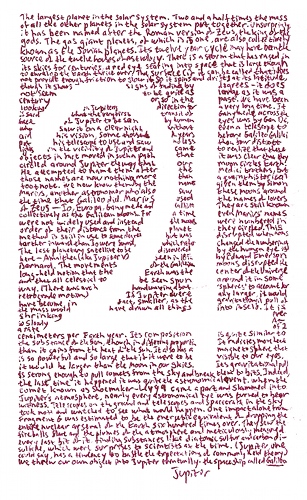 Jupiter The largest planet in the solar system.
Two and a half times the mass of all the other planets in the solar system put together.
Unsurprisingly, it has been named after the Roman version of Zeus, the king of the gods.
The gas giant planets, of which this is one, are also collectively known as the Jovian planets.
Its twelve year cycle may be been the source of the twelve houses of astrology.
There is a storm that has raged in its skies for centuries, a red eye staring into space that is large enough to envelop the Earth thrice over.
The surface (if it can be called that) does not provide enough friction to slow it, so it spins and drifts at its latitude, though it shows signs of fading by degrees–it does not seem to be quite as large as it was a century or so in the past.
We have been looking in Jupiter’s direction for a very long time.
It is said that the very first transit of Ganymede across the face of Jupiter to be seen by human eyes was by Gan De, who saw it on a clear night without even a telescope to aid his vision, some thousands of years before Galileo Galilei put his telescope to use and saw no less than four distinct lights in the vicinity of Jupiter and came to realize that these objects in fact moved in such a path that it was clear that they circled around Jupiter the way that our moon circles Earth.
He attempted to name them after the Medici brothers, but those names are now nothing more than a quaint historical footnote.
We now know them by the name given them by Simon Marius, another astronomer who also saw these moons around the time that Galileo did.
Marius used the names of lovers of Zeus–Io, Europa, Ganymede and Callisto.
They are still known collectively as the Galilean moons.
For a time even Marius’ names were not widely used and instead the moons were numbered in order of their distance from the planet they circled.
This method is still in use to some degree but was disrupted when moons farther inward than Io were found, which rather changed the numbering.
The last planetary satellite to be discovered by the human eye is here–Amalthea (aka Jupiter V) seen in 1892 by Edward Emerson Barnard.
The movements of the Galileian moons disrupted the long-held notion that the Earth was the center of the Universe and that all celestial to be seen spun around it in some way.
(There was much handwaving about ‘spheres’ to account for retrograde motion.)
If Jupiter were any larger, it would have become, in fact, smaller, as the gravitational pull of the mass would have drawn all things into itself.
It is shrinking ever so slowly. At a rate of 2 centimeters per Earth year.
Its composition is quite similar to the substance of the Sun, though in different proportion.
It radiates more heat than it gains from the heat of the Sun.
It also has a magnetosphere that is so powerful and so large that if it were to be visible to our eyes, it would be larger than the Moon in our skies.
Its gravitational pull is strong enough to pull comets from the sky and break them to bits.
Indeed, the last time it happened it was quite the astronomical event.
When the comet known as Shoemaker-Levy 9 came apart and slammed into Jupiter’s atmosphere, nearly every astronomical eye was turned to bear witness.
Telescopes on the ground and telescopes and spacecraft in the sky took note and watched to see what would happen.
One impact alone from Fragment G was estimated to be the energetic equivalent of dropping the entire nuclear arsenal of the Earth six hundred times over.
They saw the fireballs flare and the plumes of the atmosphere and meticulously measured every last bit of it, finding substances like diatomic sulfur and carbon disulfite, which were surprises to scientists at the time.
(Jupiter, one could say, has a tendency to baffle the expectations of commonly held theory.)
We threw our own object into Jupiter eventually–the spaceship called Galileo.
Again, facts were written in roughly in order of what looked interesting, from historical discoveries to the red eye storm to the sheer delightful geekery of Comet Shoemaker-Levy 9 and those who watched to see it collide with the planet. By this point, I’d gotten better at figuring out roughly how much information to gather in advance in order to fill the 3-inch-by-5-inch spaces designated for the text, which sped the process up considerably.
Prints of this work are available here.
The original is not for sale.
One of the rather disheartening things about starting out a blog is the realization that nobody but me is reading any of this. Some spammers, I suspect, rely on this loneliness to infiltrate the comments of various blogs so they can seed their links for their nefarious purposes. They use remarks that are generic enough to fit in just about anywhere and flattering enough to encourage the moderator to let them through.
At this point I don’t get enough real comments to worry about the burden of moderation but I did install a spam filter to help screen out the fake ones. And what’s particularly amusing to me is how categorically and utterly clueless these spammers look when you compare what they wrote to the entry they tried to write it in.
This post is beyond awesome. I am always wondering what to do and what not to do so I will follow some of these tips.
If you’re going to follow the ‘tips’ in Icarus Speaks of His Fall From the Heavens, I really do wonder what kind of guidance you’ve been following up to this point.
Cool, there are actually some worthwhile facts on this blog some of my readers may find this worthwhile, I must send a link, thanks.
Keep in mind that the facts in the Astronomy Series are culled mostly from Wikipedia and modified by me, so I can’t really be–wait, which entry are you commenting on? That Which Is Called the Heart? I’m not sure what ‘facts’ your readers will find worthwhile from that one.
I’m looking forward to getting more information about this topic, don’t worry about negative opinions.
I appreciate that you’re looking forward to getting more information about Star Light Star Bright but I can’t say I’ll be writing much beyond what I wrote there about it. And there haven’t been any negative opinions that anybody’s bothered to post, just a nice fellow who, well, let’s just hear him say it:
Helo
Awesome post – i’m creating video about it after i will post it to youtube !
if you wana to help or just need a link send me email !
Isn’t that sweet of him? I should really get around to emailing irwlxxjg928@gmail.com and asking him about that.
I Absolutely recognise what your stance in this matter is. Even though I should disagree on some of the finer details, I think you did an incredible job outlining it. Sure beats needing to research it by myself. Appreciate it.
Thank you for recognizing my stance on, um, Venus. So sorry we couldn’t agree on the ‘finer details’ of it. Oh, and see above about research–I wouldn’t recommend citing my artwork as a source.
I’m going to go clean out the spam trap for this week but as fresh comments accumulate I might make this a periodic entry for my own entertainment. (Pity I can’t read Russian–I get so many comments in it.)
|
|









